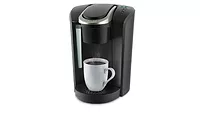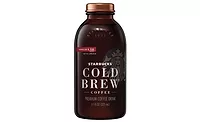2017 State of the Beverage Industry: Premiumization drives coffee category
Premium RTD, single-cup coffee grow sales




When it comes to coffee, consumers are looking for premium products in both hot and cold varieties to get their coffee fix. “Consumers are increasingly demanding specialized, high-quality coffee products, particularly in single-use servings. Over the past five years, many consumers have viewed high-quality industry products as an affordable luxury,” Los Angeles-based IBISWorld states in its February 2017 report titled “Coffee Production in the US.”
For the five years to 2022, the market research firm predicts growth at an annualized rate of 0.4 percent, bringing the market to $13.6 billion.
As consumers look for more premium coffee offerings, the market has accommodated the demand.
“As with most consumer product categories today, premiumization is on the rise,” said Gary Hemphill, managing director of research for New York-based Beverage Marketing Corporation (BMC), in Beverage Industry’s October 2016 issue. “Driven by a steadily improving economy, consumers are trading up to higher-quality products that offer value. In coffee, cold brew is a prime example of this, as is the ascent of higher priced specialty coffee.”
Cold-brew coffee not only is appealing to premium beverage trends, but also health-and-wellness ones, noted Virginia Lee, senior beverages analyst for Chicago-based Euromonitor International, in the October 2016 issue of Beverage Industry.
“These premium cold-brew coffees have resonated with millennial consumers who not only appreciate the coffee’s smoother taste but its higher caffeine content,” she explained. “The addition of cold-brew formulas is also expanding the consumer base for U.S. [ready-to-drink] RTD coffee beyond fans of the Starbucks Frappuccino.”
Elizabeth Sisel, former beverage analyst with Chicago-based Mintel, also noted the positive impact that cold brew is having
on the coffee category, but highlighted that its growth still comes from a small base.
“[C]old brew is still way too small for its sales to have a large impact on the category — it makes up less than 1 percent of the total RTD coffee segment sales,” she said in Beverage Industry’s October 2016 issue.
The hot coffee market also is innovating to appeal to consumers’ premium tastes and desire for convenience. According to data from Chicago-based Information Resources Inc. (IRI), the single-cup segment saw sales rise 2.3 percent in U.S. multi-outlets and convenience stores for the
52 weeks ended May 14.
Single-origin and -estate, along with organic and Fair Trade, coffee attributes, have experienced increased demand, Euromonitor’s Lee noted in Beverage Industry’s October 2016 issue.
Because of the focus on premium coffee, as well as increasing options, not all coffee segments have seen sales proliferate.
“Ground and whole bean coffee sold through traditional retail outlets have been experiencing flat to down performance as consumers increasingly opt to purchase their coffee through different formats,” BMC’s Hemphill said in Beverage Industry’s October 2016 issue.
Part of this performance could be attributed to these segments’ established markets. “The ground/bean coffee segment has plateaued, which is not surprising given its long-standing presence in the U.S. and that its market share has likely reached a peak with current consumers,” Mintel’s Sisel said in Beverage Industry’s October 2016 issue.
Although the ground and whole bean segments have been relatively stagnant in sales, the premiumization trends permeating throughout the category could benefit all coffee segments, she explained.
“Consumers are evolving into more sophisticated coffee drinkers and are looking for new ways to experience a favorite drink option, which will continue to fuel interest and participation in the premiumized coffee space across the ground/bean, single-cup and RTD coffee segments,” Sisel said. BI
Top refrigerated ready-to-drink coffee
(Individual brands)
| International Delight | $63,746,712 | 3.2 | 25.92 | -4.8 |
| Starbucks Iced Espresso Classics | $50,862,840 | 11.6 | 20.68 | -2.0 |
| Starbucks Coffee | $44,110,908 | 27.6 | 17.94 | 0.8 |
| Califia Farms | $30,533,326 | 126.9 | 12.42 | 5.7 |
| Bolthouse Farms Perfectly Protn | $17,174,516 | -22.5 | 6.98 | -4.0 |
| Category Total* | $245,932,496 | 22.3 | 100.0 | - |
*Includes brands not listed.
Source: Information Resources Inc. (IRI), Chicago. Total U.S. supermarkets, drug stores, gas and convenience stores, mass merchandisers, military commissaries, and select club and dollar retail chains for the 52 weeks ending May 14.
Top ground coffees
(Individual brands)
| Folgers | $1,166,560,896 | -6.5 | 29.0 | -1.3 |
| Maxwell House | $559,476,544 | -4.9 | 13.9 | -0.4 |
| Starbucks | $415,413,344 | 10.5 | 10.3 | 1.2 |
| Private label | $368,728,192 | -2.7 | 9.2 | -0.1 |
| Dunkin' Donuts | $282,190,560 | -2.8 | 7.0 | 0.0 |
| Category Total* | $4,024,677,120 | -2.2 | 100.0 | - |
*Includes brands not listed.
Source: Information Resources Inc. (IRI), Chicago. Total U.S. supermarkets, drug stores, gas and convenience stores, mass merchandisers, military commissaries, and select club and dollar retail chains for the 52 weeks ending May 14.
Top single-cup coffees
(Individual brands)
| Private label | $720,002,816 | 31.1 | 18.4 | 4.1 |
| Starbucks | $620,991,808 | 8.9 | 15.9 | 1.0 |
| Keurig Green Mountain | $413,650,240 | -9.4 | 10.6 | -1.4 |
| Keurig Donut Shop | $263,151,152 | -2.6 | 6.7 | -0.3 |
| Dunkin' Donuts | $255,744,256 | 17.1 | 6.5 | 0.8 |
| Category Total* | $3,913,999,360 | 2.3 | 100.0 | - |
*Includes brands not listed.
Source: Information Resources Inc. (IRI), Chicago. Total U.S. supermarkets, drug stores, gas and convenience stores, mass merchandisers, military commissaries, and select club and dollar retail chains for the 52 weeks ending May 14.
Looking for a reprint of this article?
From high-res PDFs to custom plaques, order your copy today!





